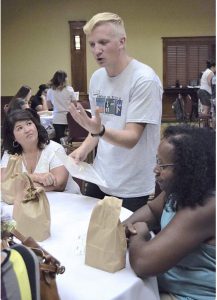By Judy L. Bedell
SACRAMENTO — Austin Miller says that “connecting students to agriculture is more important now than ever before.”
Growing up in tiny Scio, Ore., he has fond memories of spending summers on his grandparents’ ranch.
He also has fond memories of growing up with the Capital Press newspaper.
“I first got to know Capital Press in high school ag class. Every Friday or Monday we would pass the paper around, and we used the info for various projects,” Miller said.
A Capital Press representative was looking for people to sell subscriptions at the Oregon State Fair in 2013 “so I signed up,” said Miller, who sold subscriptions for three years at the fair and to friends and family on the side.
“Selling subscriptions at the Oregon State Fair was a lot of fun,” he said. “There were so many people who were diehard fans, and they came by the booth each year to renew their subscription at the fair.”
Miller has always been a “people” person, so once he graduated from Oregon State University with a major in agriculture, an informal focus in ag education and a minor in comparative international agriculture, he was ready to put those attributes to work.
He started with the Oregon Agriculture in the Classroom Foundation while still in college and then made the jump to the California Foundation for Agriculture in the Classroom earlier this year as the program coordinator of communications.
“Here in California agriculture is always growing and changing. I believe the pushback that ag receives is not going away. It is a great blessing to be able to choose and make opinions about what we eat and buy but we have a huge need to educate people to make informed decisions,” Miller said.
“For those of us involved in ag, we have a clear picture of what it means but to the consumer or teacher, you have to break it down into something they can relate to. Make sure they know ag is the food they eat and the clothes they wear,” Miller explained.
“We came up with the ‘5 F’s of Ag: Food, Fiber, Fish, Forestry and Fuel,’” he said. “It gets people talking and asking questions.”
For example, he said, “biofuel is a big part of the message we are working on. It is a fun way to connect ag to science. Students love the lessons we have on turning cow poop into electricity. They not only learn but they don’t forget and it gets them talking and wondering.”
One of the biggest challenges Miller faces is getting accurate information on agriculture to urban teachers and those without an agriculture background.
“We are really working on our website as a resource for teachers to find standards-based lessons that are clear, easy to follow and fun. We update the information throughout the month and I am an email away if someone needs help,” Miller said.
On the website teachers can find mini-lessons, fact cards, grants, lesson plans and contests. The “Imagine This…” writing contest starts this fall and is a way to involve students in grades 3-8 in agriculture. Details and examples of past winning stories can all be found on the website.
Miller keeps himself busy spreading the word and making it easy for teachers to incorporate agriculture into the classroom.
Resources and materials for taking agriculture into the classroom can be found at learnaboutag.org.



